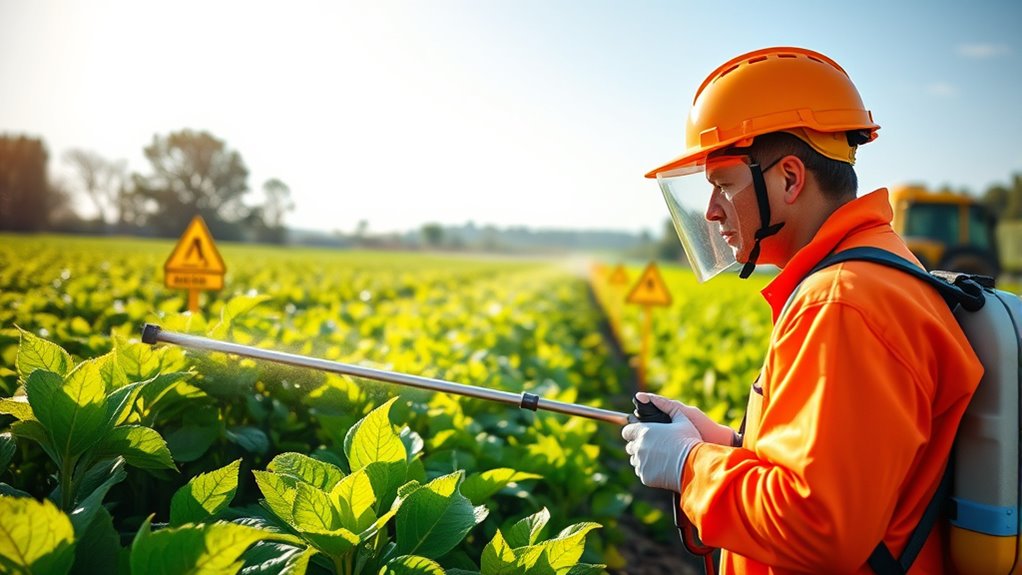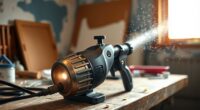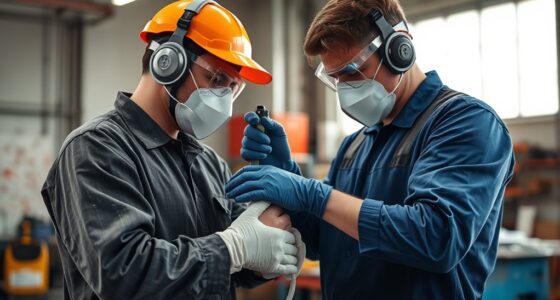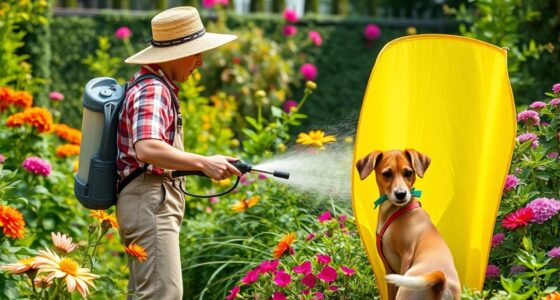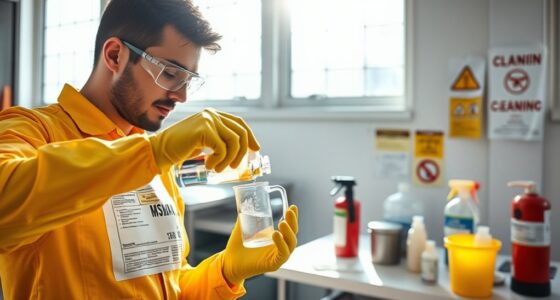To identify and avoid common spraying hazards, always understand the chemicals you’re using, including their toxicity and reactivity. Wear proper PPE like gloves, goggles, and respirators, and make certain they’re well-maintained. Check weather conditions—avoid windy or rainy days—and keep equipment in top shape through regular inspections and calibration. Pay attention to environmental factors and follow safety protocols to prevent accidents. Exploring these safety strategies further can help keep you safe during spraying tasks.
Key Takeaways
- Conduct thorough chemical property assessments and proper labeling to prevent accidental misuse and hazardous reactions.
- Use appropriate PPE, inspect and maintain equipment regularly to minimize exposure and mechanical failures.
- Monitor weather conditions, such as wind and humidity, to reduce spray drift and environmental contamination.
- Develop and follow safety protocols for mixing, handling, and applying chemicals to avoid dangerous fumes and reactions.
- Perform routine equipment inspections and calibrations to ensure safe and effective spray application while preventing hazards.
Understanding Chemical Properties and Their Risks
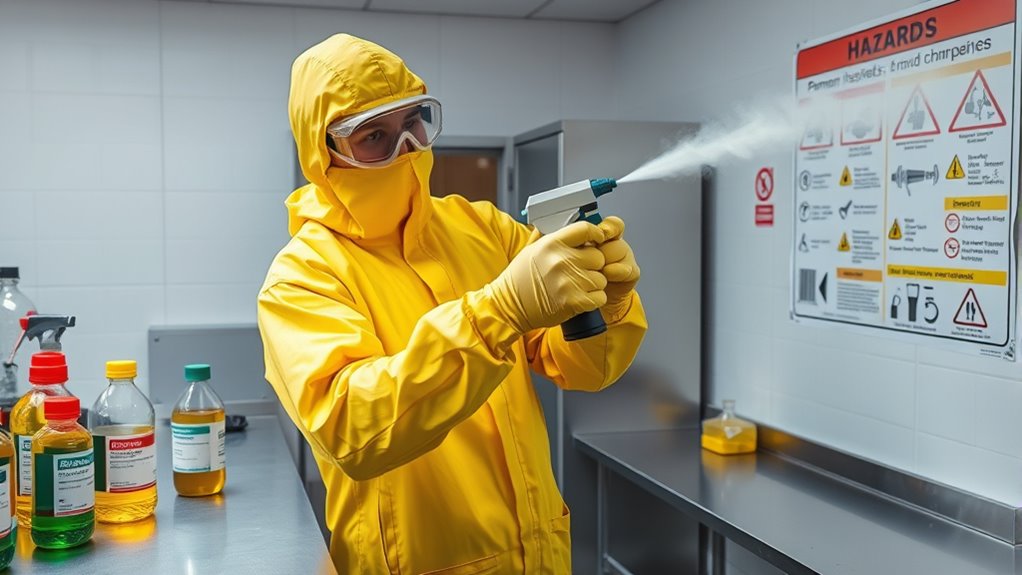
Understanding chemical properties is essential because they determine how a substance behaves during spraying. You need to be aware of chemical interactions that can occur when different chemicals mix, as these can create dangerous fumes or reactions. Knowing toxicity levels is also vital; some chemicals may be harmless in small amounts but become hazardous at higher concentrations. Additionally, understanding chemical behavior helps in developing safer handling protocols by identifying vulnerabilities in safety procedures. Recognizing chemical interactions allows you to anticipate potential hazards and implement appropriate safety measures. Being familiar with chemical stability can help prevent accidental decomposition or reactions during storage and use. Furthermore, understanding chemical reactivity is crucial for predicting how chemicals might respond under various conditions, thereby avoiding unintended hazardous outcomes. By understanding these properties, you can predict potential risks and take appropriate precautions. For example, chemicals with high toxicity levels require more careful handling and proper ventilation. Recognizing how these properties influence behavior helps you minimize exposure and prevent accidents. Ultimately, understanding chemical interactions and toxicity levels allows you to work more safely and effectively when using spraying products.
Recognizing Proper Personal Protective Equipment (PPE) Use
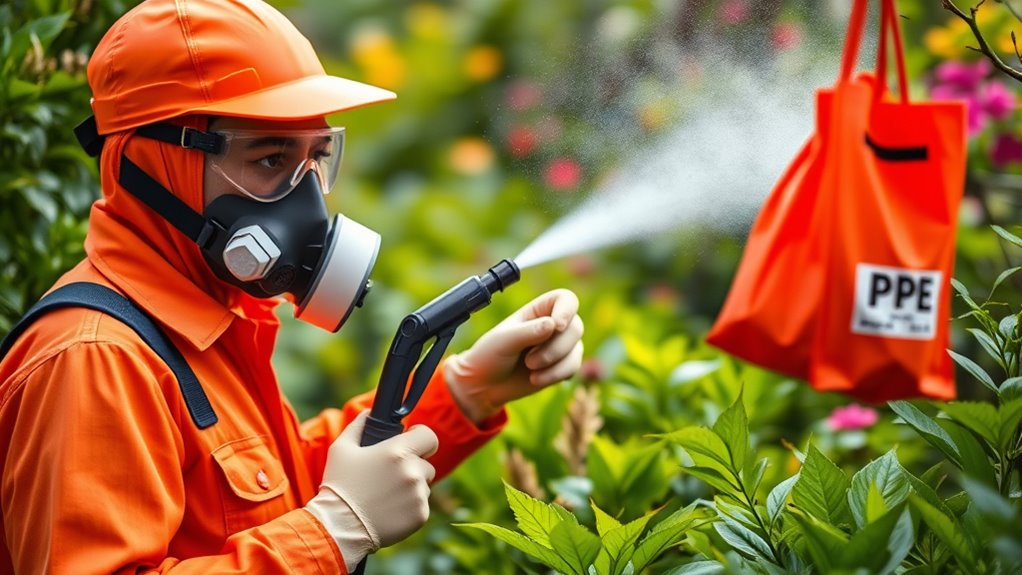
You need to select the right PPE to protect yourself effectively during spraying activities. Proper maintenance of your equipment guarantees it stays in good condition and offers maximum safety. Paying attention to these details helps you stay safe and avoid unnecessary hazards. Regularly inspecting your PPE for damage and replacing worn-out parts ensures optimal protection. Additionally, understanding air purifier maintenance and proper filter management can reduce airborne hazards and improve safety protocols. Performing routine filter replacement and cleaning can extend the lifespan of your equipment and maintain its efficacy. Properly managing automation in business can also enhance operational safety and efficiency during spraying procedures. Ensuring compatibility with your equipment, such as headphone connectors, can also prevent connection issues and enhance overall safety during operations. Incorporating dog names that reflect the environment or activity can boost morale and safety awareness among team members.
Proper PPE Selection
Are you confident you’re selecting the right PPE for spraying tasks? Proper PPE selection is *essential* to protect yourself from hazardous chemicals and sprays. Your personal gear should include gloves, goggles, and a respirator suited to the specific chemicals you’re handling. Protective clothing, like long-sleeved shirts and coveralls, shields your skin from splashes and overspray. Always check the labels and safety data sheets to determine the appropriate PPE for each task. *Make certain* your gear fits well and provides full coverage without restricting movement. Remember, the right PPE not only minimizes exposure but also boosts your confidence in working safely. Taking the time to choose suitable protective clothing and gear is a *crucial* step in avoiding spraying hazards. Proper chemical safety protocols can also help ensure your protection and reduce risk during spraying operations. Additionally, understanding best anime movies can provide a relaxing break after safety procedures. Proper outdoor transformation practices can also help create a safer and more enjoyable working environment. Incorporating glamping principles, such as using eco-friendly and durable equipment, can inspire safer and more sustainable workspaces. Being aware of vacuum cleaner performance metrics can help you select appropriate cleaning equipment to maintain a safe and healthy environment post-spraying.
PPE Maintenance Importance
Proper maintenance of your PPE is vital to guarantee it provides effective protection during spraying tasks. Regular PPE inspection helps identify signs of wear or damage that could compromise safety. Pay close attention to glove durability; worn or torn gloves may fail to protect your hands from hazardous chemicals. Keep all PPE clean and in good condition, replacing damaged items immediately. Properly maintained PPE assures a secure fit and ideal barrier against sprays and splashes. Neglecting maintenance can lead to PPE failure, increasing your risk of exposure. Developing a routine for PPE inspection and maintenance keeps your equipment reliable and extends its lifespan. Regular cleaning and storage in a dedicated location can prevent contamination and deterioration. Additionally, understanding the recognition of angel numbers can provide insights into your safety routines and alert you to necessary precautions. Recognizing the signs of Narcissistic behavior in colleagues or supervisors can help you navigate potentially manipulative interactions at work. Remember, well-maintained PPE is your first line of defense against spraying hazards. Incorporating proper PPE storage practices can further enhance its longevity and effectiveness.
Common Mistakes in Handling and Mixing Chemicals
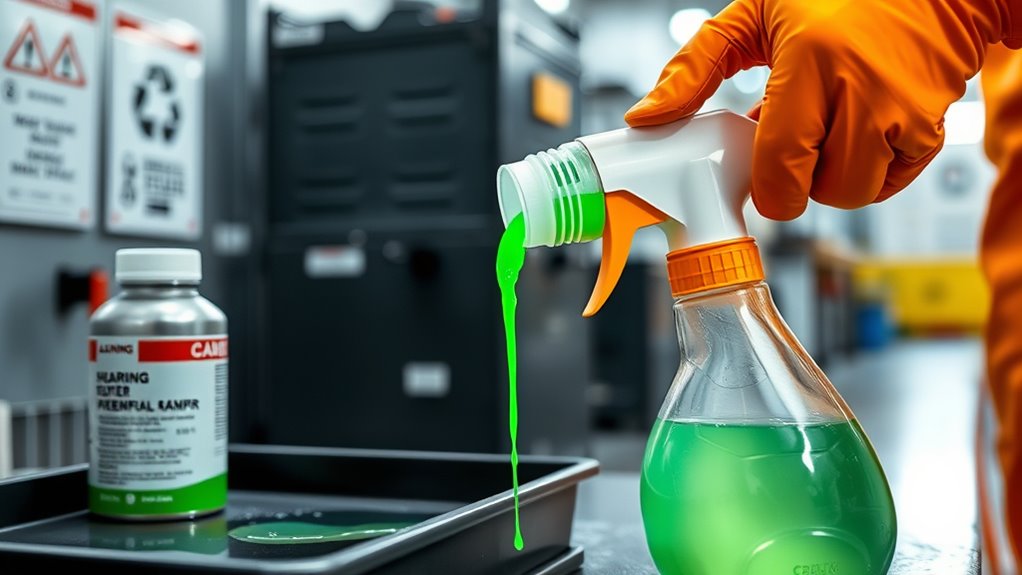
Many accidents occur because of simple mistakes made when handling and mixing chemicals. One common error is rushing the chemical mixing process, which can lead to incorrect proportions and dangerous reactions. You should always double-check labeling accuracy to guarantee you’re using the right chemicals in the correct amounts. Failing to label containers properly can cause confusion and accidental misuse later. Additionally, mixing chemicals without proper knowledge can produce hazardous fumes or reactions. To avoid these mistakes, always read labels carefully, follow instructions precisely, and verify labels before mixing. Remember, small errors in handling and labeling accuracy can have serious safety consequences. Being meticulous and attentive reduces the risk of accidents and keeps everyone safe during chemical handling. Proper chemical management planning can also help prevent costly errors and ensure safety in your chemical management processes. Maintaining a comprehensive safety protocol is essential for minimizing hazards and ensuring proper procedures are followed. Incorporating safety training for personnel can further enhance awareness and adherence to safety standards.
Environmental Factors That Increase Spray Hazards
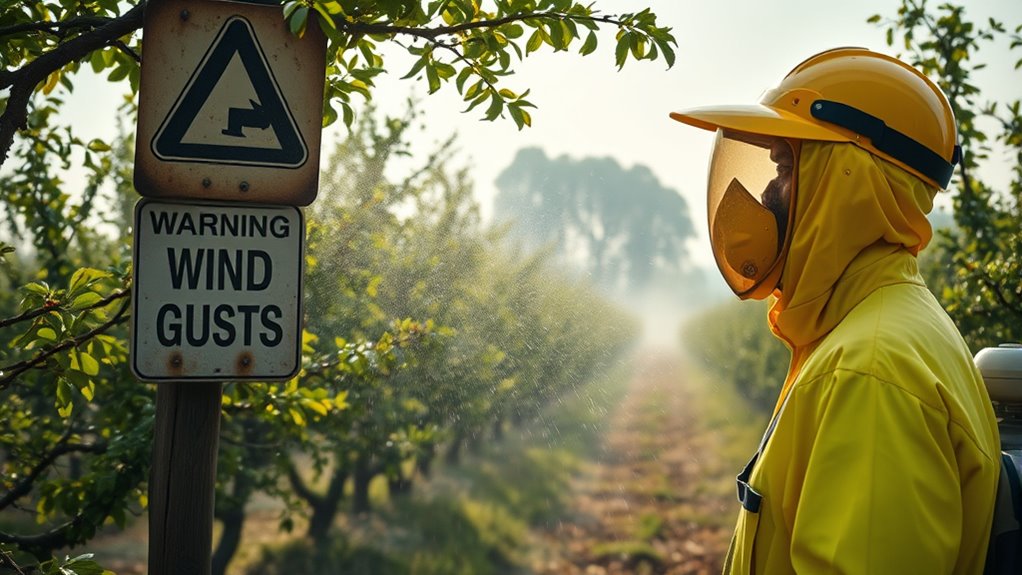
Weather conditions like wind, rain, or high temperatures can considerably increase spraying hazards by dispersing chemicals unpredictably. Poor air circulation and inadequate ventilation can also cause harmful fumes to build up, putting you at risk. Being mindful of these environmental factors helps you spray safely and effectively.
Weather Conditions Impacting Safety
When wind speeds pick up or atmospheric conditions shift unexpectedly, spray hazards can escalate quickly. Sudden increases in wind speed can cause spray drift, risking exposure to yourself and others. Humidity effects also play a role; high humidity can slow evaporation, leading to longer lingering sprays and increased exposure risks. Low humidity, on the other hand, can cause rapid evaporation, but also create dust and irritants that complicate safety.
- Wind speed fluctuations that lead to unpredictable drift
- Humidity effects that prolong spray presence or cause dust
- Sudden weather changes that reduce visibility and control
Monitoring weather conditions before spraying helps you adjust timing and protective measures. Always stay alert for shifting atmospheric conditions to minimize hazards.
Air Circulation and Ventilation
Poor air circulation and inadequate ventilation can markedly increase spray hazards by allowing airborne particles and vapors to accumulate in your work environment. Without proper air flow, harmful fumes and overspray linger, raising health risks and reducing visibility. Ventilation systems help remove these airborne contaminants, ensuring the air remains cleaner and safer. Make sure your ventilation systems are functioning correctly and are appropriately positioned to promote consistent airflow throughout your workspace. If airflow is restricted or uneven, vapors can settle in corners or low spots, creating dangerous conditions. Regularly inspecting and maintaining your ventilation setup is essential. Effective air circulation not only minimizes inhalation risks but also helps control overspray, keeping your environment safer and more comfortable during spraying operations.
The Impact of Wind and Weather Conditions
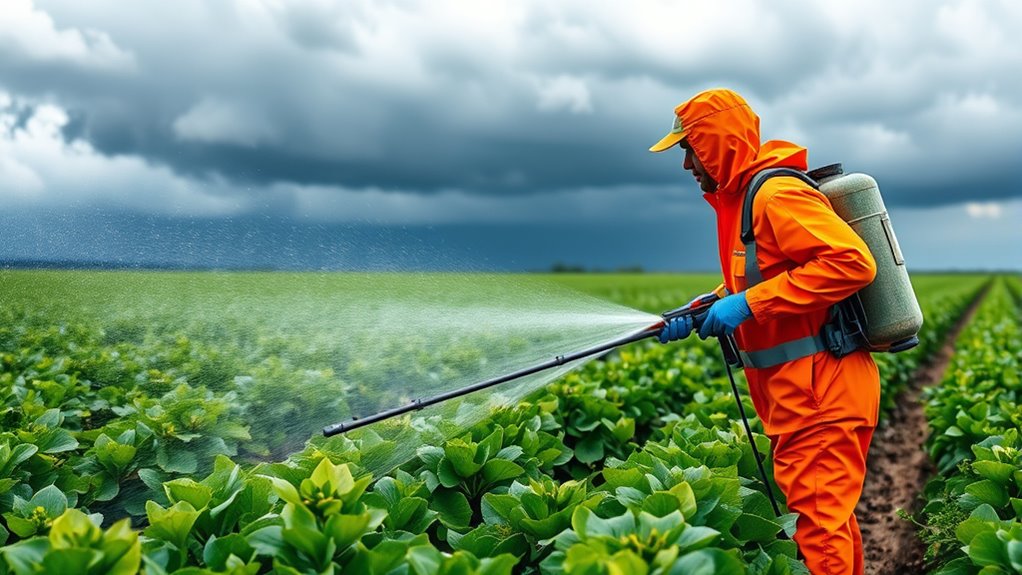
Wind and weather conditions can markedly influence the safety and effectiveness of spraying operations. Poor weather choices can lead to wind drift, where pesticides or chemicals spread beyond targeted areas, risking contamination and environmental damage. Weather hazards like rain, fog, or high humidity can reduce spray efficacy and cause uneven coverage. It’s essential to monitor conditions before spraying:
Monitor wind and weather to ensure safe, effective spraying; avoid drift and environmental hazards.
- Wind speed and direction to prevent wind drift
- Humidity and temperature that affect spray drying and drift potential
- Forecast updates to avoid sudden weather changes during application
Ignoring weather hazards can jeopardize safety, cause chemical exposure, or harm non-target areas. Always check the weather forecast, avoid spraying in high winds, and adapt your plans to current conditions to guarantee safe and effective application.
Importance of Equipment Maintenance and Inspection
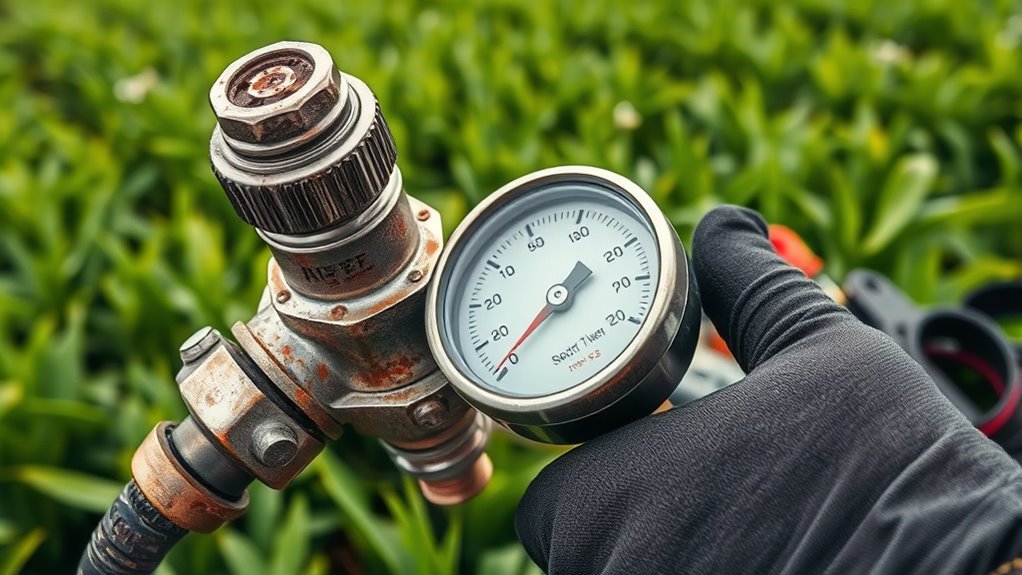
Regularly maintaining and inspecting your spraying equipment is essential to guarantee safe and effective application. Consistent checks help identify potential issues early, preventing accidents and ensuring proper functioning. Follow a strict inspection schedule to verify that parts are in good condition and that equipment is calibrated correctly. Proper calibration ensures the correct amount of chemical is applied, reducing hazards to you and the environment. Use the table below to organize your inspection tasks:
| Inspection Task | Frequency |
|---|---|
| Check for leaks and damage | Before each use |
| Verify calibration accuracy | Weekly |
| Clean and lubricate parts | After each use |
Sticking to these routines minimizes risks and maintains excellent equipment performance.
Safe Spray Application Techniques

To guarantee safe spray application, you must follow proper techniques that minimize drift and exposure. Using the right safe techniques ensures your safety and effective coverage. Always wear appropriate protective gear, like gloves, masks, and goggles, to shield yourself from harmful chemicals. Maintain consistent spray distances and avoid windy conditions to reduce drift. Adjust nozzle settings for a fine, even spray that minimizes waste. Keep your equipment well-maintained to prevent leaks or malfunctions.
- Wear protective gear at all times during application
- Spray during suitable weather conditions, avoiding wind
- Regularly check and calibrate your equipment for accuracy
Risks Associated With Contaminated or Improper Storage
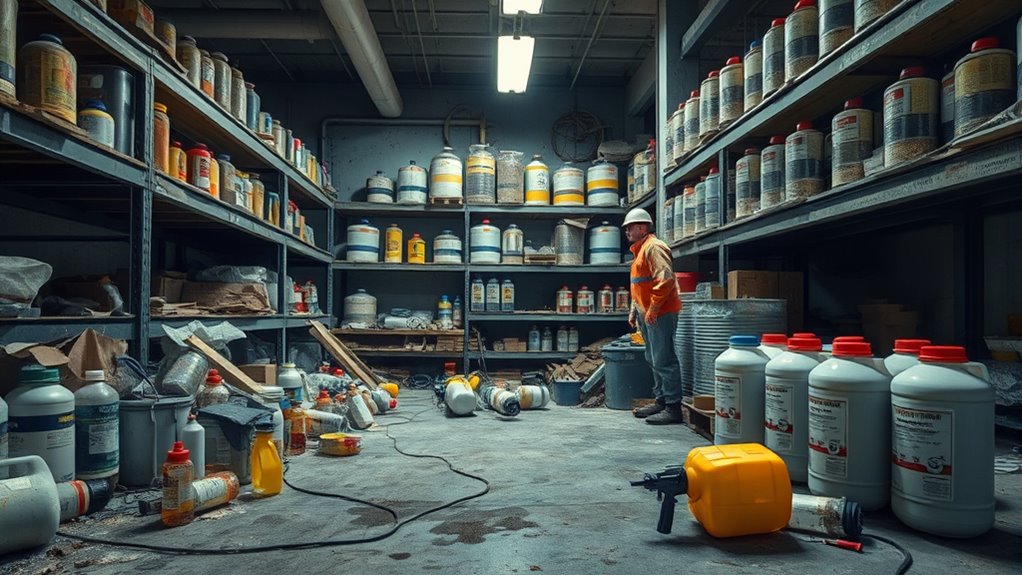
Contaminated or improperly stored chemicals pose significant risks because they can lead to accidental exposure, environmental contamination, and dangerous chemical reactions. Poor storage safety increases the chance of leaks, spills, or fumes that can harm you and others nearby. To prevent these hazards, you must guarantee chemicals are stored in properly labeled, secure containers, and kept in designated areas away from incompatible substances. Regular inspection helps detect leaks or deterioration early, reducing contamination risks. Proper ventilation and temperature control are essential to maintain chemical stability. Implementing contamination prevention measures and following storage safety guidelines protect both your health and the environment. Always prioritize correct storage practices to minimize hazards and ensure a safe working environment.
Emergency Response and First Aid Procedures

When a chemical spill or exposure occurs, knowing how to respond quickly can prevent serious injuries and minimize damage. Your first step is to confirm safety — move away from the spill area and alert others. For a chemical spill, immediately ventilate the area if possible, and use protective gear. In case of skin contact, rinse thoroughly with water and remove contaminated clothing. If chemicals contact your eyes, flush with water for at least 15 minutes and seek medical attention. For inhalation, move to fresh air immediately. Remember, quick action is crucial for effective first aid. Keep emergency contact numbers handy, and always follow your organization’s spill response protocols.
- Keep a first aid kit accessible and stocked
- Know the location of emergency showers and eyewash stations
- Report incidents immediately to supervisors
Frequently Asked Questions
How Can I Identify Hidden Chemical Hazards in My Spray Work Area?
You can identify hidden chemical hazards in your spray work area by inspecting chemical storage carefully for leaks or spills, and checking labels for unknown substances. Always wear protective clothing to prevent exposure. Be aware of unusual odors or fumes, which might indicate hidden hazards. Regularly review safety data sheets, and ensure proper labeling and storage practices. Staying vigilant helps you recognize potential dangers before they cause harm.
What Are the Signs of Chemical Exposure During Spraying?
Picture your body as a warning flag waving in the wind. When you notice symptom recognition like headaches, dizziness, or skin irritation, it’s a sign of exposure symptoms from chemicals. Your body’s signals are the safety alarms, alerting you that something’s wrong. Stay vigilant, take immediate action, and remove yourself from the spray area to prevent further harm. Recognizing these signs keeps you safe and healthy.
How Can I Prevent Accidental Spray Leaks or Spills?
To prevent accidental spray leaks or spills, always wear protective gear like gloves, goggles, and masks. Make certain your equipment is well-maintained, checking hoses, seals, and nozzles regularly for damage or wear. Handle chemicals carefully, following proper procedures, and double-check connections before spraying. Properly storing and labeling chemicals also helps avoid spills. Taking these steps keeps you safe and minimizes the risk of leaks during spraying activities.
Are There Specific Safety Protocols for Working at Heights?
You might think safety protocols are only for ground work, but working at heights demands strict precautions. Always wear a properly fitted safety harness and use fall protection equipment. Before starting, inspect all gear for damage and make sure anchorage points are secure. Remember, even a small oversight can lead to serious injury. Adhering to these protocols keeps you safe, preventing falls and ensuring you can focus on your task confidently.
How Should I Dispose of Leftover Chemicals Safely?
When disposing of leftover chemicals, you should follow proper chemical storage guidelines and wear protective equipment like gloves and goggles. Check the chemical’s label for disposal instructions, and never pour leftovers down drains or onto the ground. Instead, take them to a designated hazardous waste facility. This guarantees you’re protecting yourself and the environment, reducing risk, and complying with safety regulations. Always handle chemicals carefully and stay informed about proper disposal methods.
Conclusion
So, next time you think about skipping PPE or rushing through equipment checks, remember—it’s the safest way to turn a simple spray into a hazardous mess. Ironically, the very shortcuts meant to save time can lead to costly accidents or health issues. Stay cautious, follow proper procedures, and you’ll avoid turning your job into a cautionary tale. Because, after all, a little extra effort now keeps the hazards far away later.
